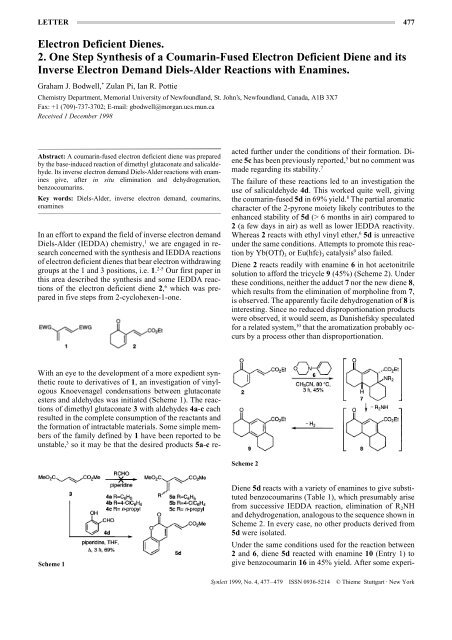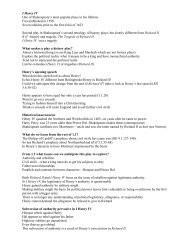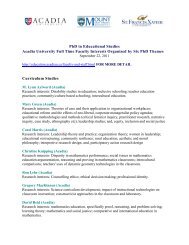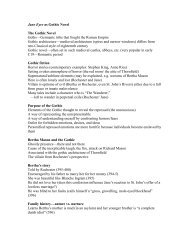Electron Deficient Dienes. 2. One Step Synthesis of a Coumarin ...
Electron Deficient Dienes. 2. One Step Synthesis of a Coumarin ...
Electron Deficient Dienes. 2. One Step Synthesis of a Coumarin ...
Create successful ePaper yourself
Turn your PDF publications into a flip-book with our unique Google optimized e-Paper software.
LETTER 477<br />
<strong>Electron</strong> <strong>Deficient</strong> <strong>Dienes</strong>.<br />
<strong>2.</strong> <strong>One</strong> <strong>Step</strong> <strong>Synthesis</strong> <strong>of</strong> a <strong>Coumarin</strong>-Fused <strong>Electron</strong> <strong>Deficient</strong> Diene and its<br />
Inverse <strong>Electron</strong> Demand Diels-Alder Reactions with Enamines.<br />
Graham J. Bodwell, * Zulan Pi, Ian R. Pottie<br />
Chemistry Department, Memorial University <strong>of</strong> Newfoundland, St. John’s, Newfoundland, Canada, A1B 3X7<br />
Fax: +1 (709)-737-3702; E-mail: gbodwell@morgan.ucs.mun.ca<br />
Received 1 December 1998<br />
Abstract: A coumarin-fused electron deficient diene was prepared<br />
by the base-induced reaction <strong>of</strong> dimethyl glutaconate and salicaldehyde.<br />
Its inverse electron demand Diels-Alder reactions with enamines<br />
give, after in situ elimination and dehydrogenation,<br />
benzocoumarins.<br />
Key words: Diels-Alder, inverse electron demand, coumarins,<br />
enamines<br />
In an effort to expand the field <strong>of</strong> inverse electron demand<br />
Diels-Alder (IEDDA) chemistry, 1 we are engaged in research<br />
concerned with the synthesis and IEDDA reactions<br />
<strong>of</strong> electron deficient dienes that bear electron withdrawing<br />
groups at the 1 and 3 positions, i.e. 1. 2-5 Our first paper in<br />
this area described the synthesis and some IEDDA reactions<br />
<strong>of</strong> the electron deficient diene 2, 6 which was prepared<br />
in five steps from 2-cyclohexen-1-one.<br />
With an eye to the development <strong>of</strong> a more expedient synthetic<br />
route to derivatives <strong>of</strong> 1, an investigation <strong>of</strong> vinylogous<br />
Knoevenagel condensations between glutaconate<br />
esters and aldehydes was initiated (Scheme 1). The reactions<br />
<strong>of</strong> dimethyl glutaconate 3 with aldehydes 4a-c each<br />
resulted in the complete consumption <strong>of</strong> the reactants and<br />
the formation <strong>of</strong> intractable materials. Some simple members<br />
<strong>of</strong> the family defined by 1 have been reported to be<br />
unstable, 3 so it may be that the desired products 5a-c reacted<br />
further under the conditions <strong>of</strong> their formation. Diene<br />
5c has been previously reported, 5 but no comment was<br />
made regarding its stability. 7<br />
The failure <strong>of</strong> these reactions led to an investigation the<br />
use <strong>of</strong> salicaldehyde 4d. This worked quite well, giving<br />
the coumarin-fused 5d in 69% yield. 8 The partial aromatic<br />
character <strong>of</strong> the 2-pyrone moiety likely contributes to the<br />
enhanced stability <strong>of</strong> 5d (> 6 months in air) compared to<br />
2 (a few days in air) as well as lower IEDDA reactivity.<br />
Whereas 2 reacts with ethyl vinyl ether, 6 5d is unreactive<br />
under the same conditions. Attempts to promote this reaction<br />
by Yb(OTf) 3 or Eu(hfc) 3 catalysis 9 also failed.<br />
Diene 2 reacts readily with enamine 6 in hot acetonitrile<br />
solution to afford the tricycle 9 (45%) (Scheme 2). Under<br />
these conditions, neither the adduct 7 nor the new diene 8,<br />
which results from the elimination <strong>of</strong> morpholine from 7,<br />
is observed. The apparently facile dehydrogenation <strong>of</strong> 8 is<br />
interesting. Since no reduced disproportionation products<br />
were observed, it would seem, as Danishefsky speculated<br />
for a related system, 10 that the aromatization probably occurs<br />
by a process other than disproportionation.<br />
Scheme 2<br />
Scheme 1<br />
Diene 5d reacts with a variety <strong>of</strong> enamines to give substituted<br />
benzocoumarins (Table 1), which presumably arise<br />
from successive IEDDA reaction, elimination <strong>of</strong> R 2 NH<br />
and dehydrogenation, analogous to the sequence shown in<br />
Scheme <strong>2.</strong> In every case, no other products derived from<br />
5d were isolated.<br />
Under the same conditions used for the reaction between<br />
2 and 6, diene 5d reacted with enamine 10 (Entry 1) to<br />
give benzocoumarin 16 in 45% yield. After some experi-<br />
Synlett 1999, No. 4, 477–479 ISSN 0936-5214 © Thieme Stuttgart · New York
478 G. J. Bodwell et al. LETTER<br />
Table 1<br />
mentation with the reaction conditions (Entries 2-6), it<br />
was found that equivalent yields could be obtained at<br />
room temperature after just 1 h by using CH 2 Cl 2 as the solvent.<br />
The greater solubility <strong>of</strong> 5d in CH 2 Cl 2 allowed the<br />
reaction to be run at higher concentration than in CH 3 CN.<br />
Changing the amine portion <strong>of</strong> the enamine from morpholine<br />
to pyrrolidine led to a significant increase in the yield<br />
(64%, Entry 7). Again CH 2 Cl 2 was found to be a better<br />
solvent. Worthy <strong>of</strong> note is that the corresponding reaction<br />
in CH 3 CN (Entry 8) afforded a small quantity <strong>of</strong> a byproduct<br />
17. That this compound is the hydrogenated selfcondensation<br />
product <strong>of</strong> acetophenone may provide some<br />
clue as to how the dehydrogenations are occurring. At this<br />
point room temperature reaction in CH 2 Cl 2 was chosen as<br />
our standard reaction conditions. 11<br />
Reaction <strong>of</strong> enamine 12 with 5d under standard conditions<br />
(Entry 9) gave 18 (43%). With its geminal methyl groups,<br />
enamine 13 (Entry 10) was not expected to react with 5d<br />
to give an aromatized product, but rather diene 19 (cf. 8).<br />
However the only product isolated was 20 (51%). Its formation<br />
can be explained by a [1,5]-H shift <strong>of</strong> 19. More extended<br />
conjugation and lesser steric congestion between<br />
one <strong>of</strong> the geminal methyl groups and the nearby aryl-H<br />
atom in 20 may well be responsible for the readiness with<br />
which the [1,5]-H shift occurs. AM1 calculations using<br />
the Spartan package <strong>of</strong> s<strong>of</strong>tware indicated that 20 is 7.9<br />
kcal/mol lower in energy than 19.<br />
Ketene aminal 14 12 reacted with 5d under standard conditions<br />
to afford the aromatized product 21 in 48% yield<br />
(Entry 9). None <strong>of</strong> the product 22 was obtained, which<br />
suggests that the dehydrogenation <strong>of</strong> its direct precursor<br />
(cf. 8) occurs more quickly than a [1,5]-H shift. This process<br />
would afford a compound that could aromatize via<br />
the elimination <strong>of</strong> a second molecule <strong>of</strong> piperidine.<br />
Although indoles have been reported to participate as dienophiles<br />
in IEDDA reactions, 13 N-methylindole 11 failed<br />
to react with 5d after 7 d in refluxing CH 2 Cl 2 (Entry 12).<br />
A more comprehensive investigation <strong>of</strong> the IEDDA<br />
chemistry <strong>of</strong> 5d and its derivatives is now underway, as<br />
are attempts at using the methodology described above in<br />
the synthesis <strong>of</strong> heterohelicenes and heterokekulenes.<br />
Acknowledgement<br />
The authors gratefully acknowledge the Natural Sciences and Engineering<br />
Research Council (NSERC) <strong>of</strong> Canada for financial support<br />
<strong>of</strong> this work.<br />
References and Notes<br />
(1) Boger, D. L. J. Heterocyclic Chem. 1996, 33, 1519-1531.<br />
van der Plas, H. C. Il Farmaco 1995, 50, 419-424. Afarinkia,<br />
K.; Vinader, V.; Nelson, T. D.; Posner, G. H. Tetrahedron<br />
1992, 48, 9111-9171. Boger, D. L. Bull. Soc. Chim. Belg.<br />
1990, 99, 599-615. Boger, D. L.; Weinreb, S. M. Hetero<br />
Diels-Alder Methodology in Organic <strong>Synthesis</strong>; Academic<br />
Press: New York, 1989. Boger, D. L. Chem. Rev. 1986, 86,<br />
781-793. Boger, D. L. Tetrahedron, 1983, 39, 2869-2939.<br />
(2) Prinzbach, H.; Auge, W.; Basbudak, M. Helv. Chim. Acta<br />
1971, 54, 759-764.<br />
(3) Ahn, K.-D.; Hall, H. K. J. Polym. Sci., Polym. Chem. 1981,<br />
19, 629-644.<br />
(4) Padwa, A.; Gareau, Y.; Harrison, B.; Rodriguez, A.<br />
J. Org. Chem. 1992, 57, 3540-3545. Padwa, A.; Gareau, Y.;<br />
Harrison, B.; Norman, B. H. J. Org. Chem. 1991, 56, 2713-<br />
2720. Padwa, A.; Harrison, B.; Norman, B. H. Tetrahedron<br />
Lett. 1989, 30, 3259-326<strong>2.</strong> Padwa, A.; Norman, B. H. Tetrahedron<br />
Lett. 1988, 29, 2417-2420.<br />
(5) Rossi, R.; Carpita, A.; Bellina, F.; Cossi, P. J. Organomet.<br />
Chem. 1993, 451, 33-43. Bellina, F.; Carpita, A.; Santis, M.<br />
D.; Rossia, R. Tetrahedron, 1994, 50, 12029-12046.<br />
(6) Bodwell, G. J.; Pi, Z. Tetrahedron Lett. 1997, 38, 309-31<strong>2.</strong><br />
Synlett 1999, No. 4, 477–479 ISSN 0936-5214 © Thieme Stuttgart · New York
LETTER <strong>One</strong> <strong>Step</strong> <strong>Synthesis</strong> <strong>of</strong> a <strong>Coumarin</strong>-Fused <strong>Electron</strong> <strong>Deficient</strong> Diene 479<br />
(7) 5c was reportedly (ref. 5) purified by column chromatography<br />
and thus exhibits at least a reasonable degree <strong>of</strong> stability.<br />
(8) Experimental procedure for 5d. To a magnetically stirred,<br />
room temperature solution <strong>of</strong> salicaldehyde (20.0 g, 0.164<br />
mol) and dimethyl glutaconate (25.9 g, 0.164 mol) in anhydrous<br />
THF (300 mL) was added dropwise piperidine (<strong>2.</strong>81 g,<br />
0.033 mol). The mixture was stirred for 48 h at reflux, cooled<br />
and concentrated to ca. 40 mL volume under reduced pressure.<br />
The resulting slurry was cooled at 0 °C for about 10 min<br />
and then suction filtered. The precipitate was washed with<br />
cold ether (3 x 10 mL) and then dried under high vacuum to<br />
afford 6d as a pale yellow, analytically pure solid (26.1 g,<br />
69%): m.p. 176-178 °C; 1 H NMR (300 MHz, CDCl 3 ) d 7.88<br />
(s, 1H), 7.62-7.55 (m, 2H), 7.57 (d, J = 15.9 Hz, 1H), 7.37-<br />
7.30 (m, 2H), 7.11 (d, J = 15.7 Hz, 1H), 3.81 (s, 3H); 13 C NMR<br />
(75 MHz, CDCl 3 ) d 167.3, 159.0, 153.5, 143.6, 138.0, 13<strong>2.</strong>9,<br />
128.5, 124.8, 123.2, 12<strong>2.</strong>2, 118.9, 116.9, 116.6, 51.8; IR (nujol)<br />
n = 1727 cm -1 ; UV-Vis (CH 3 OH) l max (log e) 290 (3.63),<br />
315 (3.62) nm; EIMS (70 eV) m/z (%) 230 (M + , 16), 199 (12),<br />
172 (12), 171 (100), 115 (24); Anal. Calcd for C 13 H 10 O 4 : C,<br />
67.82; H, 4.38. Found: C, 67.71; H, 4.27.<br />
(9) Marko, I. E.; Evans, G. R.; Declercq, J. P. Tetrahedron, 1994,<br />
50, 4557-4574.<br />
(10) Danishefsky, S.; Cunningham, R. J. Org. Chem. 1965, 30,<br />
3676-3678.<br />
(11) General procedure for the reaction <strong>of</strong> 5d with enamines: To a<br />
magnetically stirred, room temperature solution <strong>of</strong> diene 5d<br />
(1.00 g, 4.34 mmol) in CH 2 Cl 2 (25 mL) was added dropwise<br />
over 15 min a solution <strong>of</strong> the dienophile (6.51 mmol) in<br />
CH 2 Cl 2 (5 mL). After stirring at room temperature for 3 h, the<br />
solvent was removed under reduced pressure and the residue<br />
was chromatographed (SiO 2 , 4% ethyl acetate / CH 2 Cl 2 ).<br />
(12) Baganz, H.; Domaschke, L. Chem. Ber. 1962, 95, 2095-2096.<br />
(13) Wan, Z.-K; Snyder, J. K. Tetrahedron Lett. 1998, 39, 2487-<br />
2490.<br />
Synlett 1999, No. 4, 477–479 ISSN 0936-5214 © Thieme Stuttgart · New York







